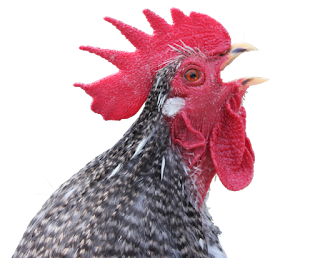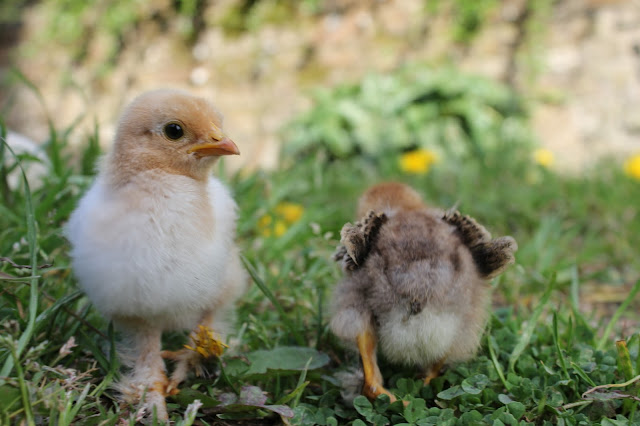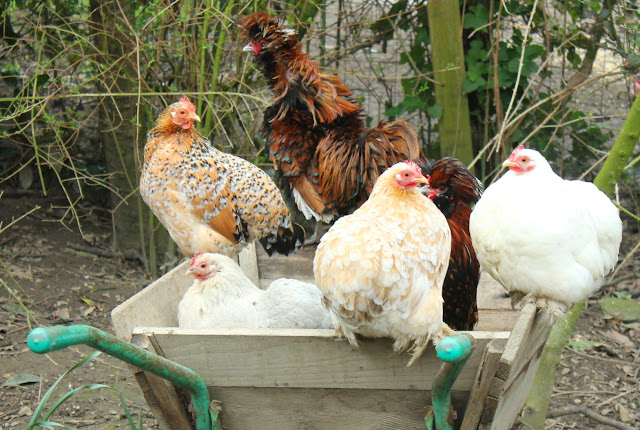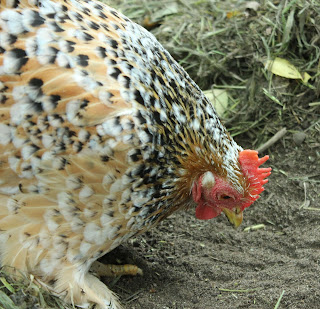In
Part One I discussed the strange history of the Cochin and how it came
into the West. In this second part I am going to look at these birds' progress and influence once they
got here.
As the breeder and author Lewis Wright expressed it:
A pair of Buff (Chamois) Cochins by J.W. Ludlow, an illustration for Wright's book.
As the breeder and author Lewis Wright expressed it:
'Cochins came in like giants upon the scene; they were seen and they conquered.'
The Game of Spin the Chicken
It was at the First Birmingham Cattle and Poultry Show of 10th December 1849 that the Great British Public amongst others, finally got to see the new Cochin or Pekin breed. Visitors went home with the idea that the Cochin could grow to an immense size, that the hen could lay several eggs a day and that the cock, whose crow was similar to the roar of a lion, could be kept in the house and make an exceptionally loving pet.All this coupled
with the idea that breeding them would be a very profitable enterprise,
drove the prices of the birds sky high creating a chicken form of Tulip
Mania.
I can see that!
After decades of disinterest, it suddenly became fashionable again for the Victorian public to attend poultry shows and to purchase and thus raise poultry. The first show in Birmingham was such a success that the following year's event took place in the brand new, purpose built 'Bingley Hall' and tens of thousands of visitors flocked to view the exciting new breeds.
As Wright attested in his 1890's Edition, in the chapter on Cochins:
From Showell's Dictionary of Birmingham:
 "Fanciers give wonderfully strange prices sometimes. Cochin China fowls
had but lately been introduced, and were therefore "the
rage" in 1851-2. At the Poultry Show in the latter year a pair of
these birds were sold for £30, and at a sale by auction
afterwards two prize birds were knocked down at £40 each: it was
said that the sellers crowed louder than the roosters"
"Fanciers give wonderfully strange prices sometimes. Cochin China fowls
had but lately been introduced, and were therefore "the
rage" in 1851-2. At the Poultry Show in the latter year a pair of
these birds were sold for £30, and at a sale by auction
afterwards two prize birds were knocked down at £40 each: it was
said that the sellers crowed louder than the roosters"
At today's prices that would be £2,991 ($4,162) for the pair and £3,989 ($5,551) each for the prize birds.
The 'Cochins Craze', as it was known in Britain was also directly responsible for the rise in the popularity of Poultry prints, books and dedicated magazines. Conversely, as seen in the Punch cartoon above, the craze also fuelled a host of satirical drawings and the usual attendant, reproving editorials in the British broadsheets.
In the USA a similar contagion 'Hen Fever' also known as 'The Fancy' swept the country. Enthusiasts and commercial breeders alike, on both sides of the Atlantic, waited eagerly at the docks as the fast clippers came in with a new cargo of Cochins. In the early days, before the prices began to rise, getting stock out of China was not that simple, as the American breeder and author, George Pickering Burnham attested:
The Cochin Craze continued to sweep through Britain and in 1853 a Cochin changed hands for the record price of £2,587 - today that would be around £188,000 ($260,481)!
Even the fertile eggs were selling like the proverbial 'hot cakes'. A March 1854 issue of The Poultry Chronicle advertised Prize White Cochin hatching eggs for £2 2s a dozen, at today's prices that is £180 ($253). If you think that is steep, then know that I recently paid £10 for two (non-exhibition) Tolbunt Polish hatching eggs and only one hatched - but she is a beauty!
According to several sources the Cochin bubble burst in 1855. However, in the edition of his work published in 1912, Lewis Wright observed that a Cochin hen, hatched from an egg originating from his own exhibition stock, having won the cup at Yarmouth in 1872:
 Wright refers to Cochins as being valued by fanciers and judges alike; 'for their great globular masses of soft plumage'. He mentions three women of the same family who were in succession found guilty of and permanently banned from, exhibiting Cochins because their birds had been 'fluffed'. Fluffing was a tedious and time-consuming practice but with the Cochin
being judged and prized for the volume of fluff, the
rewards were great. Fluffing entailed taking each feather and bending it backwards with the finger and thumb or forceps and then taking the feather a little higher up and bending it again, in the opposite direction.
Wright refers to Cochins as being valued by fanciers and judges alike; 'for their great globular masses of soft plumage'. He mentions three women of the same family who were in succession found guilty of and permanently banned from, exhibiting Cochins because their birds had been 'fluffed'. Fluffing was a tedious and time-consuming practice but with the Cochin
being judged and prized for the volume of fluff, the
rewards were great. Fluffing entailed taking each feather and bending it backwards with the finger and thumb or forceps and then taking the feather a little higher up and bending it again, in the opposite direction.
In a minor form, which was frowned upon but not judged as outright fraud, mild fluffing could be accomplished by working the feathers outwards and upwards with the hand whilst drying the bird after washing.
In Part Three I'll discuss my own experience in keeping Cochins over the past ten years, including their amazing versatility and ability to respond to new situations, including raising all kinds of chicks. Please also feel free to comment and or share this article.
Hope you enjoyed this piece, as with the previous one, it has taken me many weeks to research. If you would like to republish any of this material please do give me credit and I hope it will also inspire you to go on and read more about these fascinating birds, their unique history and influences on poultry keeping today.
All the very best,
Sue
© 2018 Sue Cross
Hunter, A.F., 1904. The Asiatics Brahmas, Cochins and Langshans
Wright, L., 1890. The Illustrated Book of Poultry with Practical Schedules for Judging.
Wright, L., Lewer, S.H., 1912. The Illustrated Book of Poultry with Practical Schedules for Judging, (re-written).
Harman, T.T., 1885. Showell's dictionary of Birmingham. A history and guide ... containing thousands of dates and references to matters of interest connected with the past and present history of the town.
Burnham, G.P., 1874. The China Fowl. Shanghae, Cochin and "Brahma".
The Poultry Chronicle, 1854. A bound volume of the weekly magazine published by Bradbury and Evans.
Additional images from Pinterest thanks to:
etsy.com
RETURN TO CONTENTS PAGE
I can see that!
After decades of disinterest, it suddenly became fashionable again for the Victorian public to attend poultry shows and to purchase and thus raise poultry. The first show in Birmingham was such a success that the following year's event took place in the brand new, purpose built 'Bingley Hall' and tens of thousands of visitors flocked to view the exciting new breeds.
As Wright attested in his 1890's Edition, in the chapter on Cochins:
'The introduction of these fowls...was a memorable event in the history of poultry; since they undoubtedly awakened a startling "mania" which was, calmly considered, one of the most curious phenomena of the nineteenth century, and which, after it had died away, left behind it an enduring interest which nothing has been able to destroy.'
The Cochin Bubble
From Showell's Dictionary of Birmingham:
 "Fanciers give wonderfully strange prices sometimes. Cochin China fowls
had but lately been introduced, and were therefore "the
rage" in 1851-2. At the Poultry Show in the latter year a pair of
these birds were sold for £30, and at a sale by auction
afterwards two prize birds were knocked down at £40 each: it was
said that the sellers crowed louder than the roosters"
"Fanciers give wonderfully strange prices sometimes. Cochin China fowls
had but lately been introduced, and were therefore "the
rage" in 1851-2. At the Poultry Show in the latter year a pair of
these birds were sold for £30, and at a sale by auction
afterwards two prize birds were knocked down at £40 each: it was
said that the sellers crowed louder than the roosters"
At today's prices that would be £2,991 ($4,162) for the pair and £3,989 ($5,551) each for the prize birds.
The 'Cochins Craze', as it was known in Britain was also directly responsible for the rise in the popularity of Poultry prints, books and dedicated magazines. Conversely, as seen in the Punch cartoon above, the craze also fuelled a host of satirical drawings and the usual attendant, reproving editorials in the British broadsheets.
In the USA a similar contagion 'Hen Fever' also known as 'The Fancy' swept the country. Enthusiasts and commercial breeders alike, on both sides of the Atlantic, waited eagerly at the docks as the fast clippers came in with a new cargo of Cochins. In the early days, before the prices began to rise, getting stock out of China was not that simple, as the American breeder and author, George Pickering Burnham attested:
'As can well be understood, the mass of gentlemen or businessmen who go from the West to China possess neither the taste, the knowledge, or the inclination to concern themselves about looking up poultry in that far away land.... Secondly the ship-masters and sailors who go there, know little or nothing of the poultry (except to eat it when cooked).... Thus the latter class never trouble themselves to secure any particular style, shape, color or sized fowl.'The difficulties in obtaining good specimens and in particular those that would stand the rigours of the voyage, which included typhoons, pirate attacks and being neglected and cooped up on shipboard for months, probably made the Cochin the magnificent creature it is today!
The Cochin Craze continued to sweep through Britain and in 1853 a Cochin changed hands for the record price of £2,587 - today that would be around £188,000 ($260,481)!
Even the fertile eggs were selling like the proverbial 'hot cakes'. A March 1854 issue of The Poultry Chronicle advertised Prize White Cochin hatching eggs for £2 2s a dozen, at today's prices that is £180 ($253). If you think that is steep, then know that I recently paid £10 for two (non-exhibition) Tolbunt Polish hatching eggs and only one hatched - but she is a beauty!
According to several sources the Cochin bubble burst in 1855. However, in the edition of his work published in 1912, Lewis Wright observed that a Cochin hen, hatched from an egg originating from his own exhibition stock, having won the cup at Yarmouth in 1872:
'...was pronounced by the judge the best he ever saw, and purchased by Mr Horace Lingwood for £20, the highest price given for a single hen up to that date since the early Cochin mania.'(At today's prices: £1,639 ($2,273).
Cochin Chicanery
With the feverish interest shown by the fanciers and a public whipped up into Cochin "mania" by the press, it was perhaps to be expected that fakery would also be on the rise. It was to become a particular problem at competition level, where as we have seen above, prize Cochins could command exceptional prices, even for their eggs. Fraud appeared in many forms at exhibition, from the clipping and dying of plumage to the plucking of imperfect feathers and the addition of fake ones, particularly sickles. This was rife in all kinds of exhibition birds but for the Cochin it was 'fluffing' that was a particular favourite amongst the unscrupulous breeders.Fluffing
 Wright refers to Cochins as being valued by fanciers and judges alike; 'for their great globular masses of soft plumage'. He mentions three women of the same family who were in succession found guilty of and permanently banned from, exhibiting Cochins because their birds had been 'fluffed'. Fluffing was a tedious and time-consuming practice but with the Cochin
being judged and prized for the volume of fluff, the
rewards were great. Fluffing entailed taking each feather and bending it backwards with the finger and thumb or forceps and then taking the feather a little higher up and bending it again, in the opposite direction.
Wright refers to Cochins as being valued by fanciers and judges alike; 'for their great globular masses of soft plumage'. He mentions three women of the same family who were in succession found guilty of and permanently banned from, exhibiting Cochins because their birds had been 'fluffed'. Fluffing was a tedious and time-consuming practice but with the Cochin
being judged and prized for the volume of fluff, the
rewards were great. Fluffing entailed taking each feather and bending it backwards with the finger and thumb or forceps and then taking the feather a little higher up and bending it again, in the opposite direction.In a minor form, which was frowned upon but not judged as outright fraud, mild fluffing could be accomplished by working the feathers outwards and upwards with the hand whilst drying the bird after washing.
Here above 'Cafe-latte' and below 'Fluffy' demonstrate what a Cochin with naturally bent backwards or rather frizzled feathers looks like!
In Part Three I'll discuss my own experience in keeping Cochins over the past ten years, including their amazing versatility and ability to respond to new situations, including raising all kinds of chicks. Please also feel free to comment and or share this article.
Hope you enjoyed this piece, as with the previous one, it has taken me many weeks to research. If you would like to republish any of this material please do give me credit and I hope it will also inspire you to go on and read more about these fascinating birds, their unique history and influences on poultry keeping today.
All the very best,
Sue
© 2018 Sue Cross
RELATED ARTICLES
The Cochin Craze 3. Choosing Cochins for Your Garden
The Cochin like all ancient breeds are excellent foragers and quickly
become a vital part of any garden, keeping down weeds and pests. And as
not all of the Cochin Craze story was 'spin',..read more
 The Cochin Craze 1 - A Story of Addiction
The Cochin Craze 1 - A Story of Addiction
These fluffy bundles, which I have been raising
for ten years have a unique and fascinatingly terrible history,
involving bloody wars, tea, silver and above all opium. A three part article on the chicken version of Tulip Mania and my own Cochin..read more
Polish Crested - Beauty, Brains and Rusticity.
It's hard to believe that a creature which looks so frou-frou can be anything but ornamental and therefore totally unsuited to a backyard or smallholding but in the following article...read more
 Frizzles for a Forest Garden Part 1
Frizzles for a Forest Garden Part 1
In some countries, such as here in France, Frizzles are often viewed as
an individual breed rather than a form of feather mutation, which can
occur across several races...read more
Frizzles for a Forest Garden 2 Behaviour & Emotions
Spike is a fine example of a Polish Frizzle and has also something
which I believe well illustrates the dilemma faced by the Frizzled
bird...read more
References:
Available to read freely on-line and to download in various formats at the Internet Archive:Hunter, A.F., 1904. The Asiatics Brahmas, Cochins and Langshans
Wright, L., 1890. The Illustrated Book of Poultry with Practical Schedules for Judging.
Wright, L., Lewer, S.H., 1912. The Illustrated Book of Poultry with Practical Schedules for Judging, (re-written).
Harman, T.T., 1885. Showell's dictionary of Birmingham. A history and guide ... containing thousands of dates and references to matters of interest connected with the past and present history of the town.
Burnham, G.P., 1874. The China Fowl. Shanghae, Cochin and "Brahma".
The Poultry Chronicle, 1854. A bound volume of the weekly magazine published by Bradbury and Evans.
Additional images from Pinterest thanks to:
etsy.com















I got goosebumps reading your incredible articles p1 and 2! As I admired the beauty of my Cochin cockerel I thought how majestic he appears. Now I understand how truly majestic he IS! I am in awe of the rich history and can indulge in imagining the ancestry’s saga that led my little bantam Cochin, Napoleon, into my modest little backyard in Southern California. Brava!
ReplyDeleteIncredibly grateful,
Ana ❤️
Hi there Ana (and Napoleon!), I am so happy you enjoyed these two articles. I loved researching them and it took me through an era in our history of which I had only had a passing knowledge. I can imagine how our Cochins' spirits were forged on the decks of those clippers - it would have taken a mighty strong bird both physically and mentally to survive such a voyage. Even in the way Cochins walk, you can see their regal bearing. I once had a friend to tea in the garden and she gave one of, I thought the best descriptions of my Cuckoo Cochin hen as she came jauntily up the path towards us: 'and where are you going my little hen in you fancy pyjamas?' She got the answer soon enough, Cuckoo was heading for the sponge cake and snuck a huge piece before we could do anything about it! BTW Cochin chicks are sooo beautiful - I hope you fill you whole backyard with them! All the very best from Normandie, Sue xxx
Deletethis is so awesome, as a cochin owner myself, this is so cool!
ReplyDelete